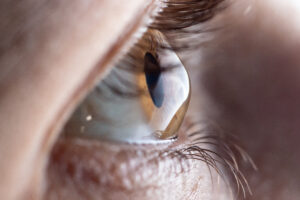
Many eye diseases primarily affect older people. That is not true of keratoconus, a corneal condition that often appears in children and young adults. Keratoconus treatment depends on the condition, severity and progression. Here the doctors at Mack Eye Center explain how keratoconus is treated.
What Is Keratoconus?
If your cornea, the eye’s normally round front surface, starts thinning and bulging, the result is keratoconus. Symptoms include blurred or distorted vision as corneal bulging changes the way light rays are perceived. Patients may experience light sensitivity and a greater reaction to glare. Eye itchiness is also common.
In time, progressive myopia or astigmatism develops. Suspect potential keratoconus if you find yourself needing to change your prescriptions for eyeglasses or contact lenses frequently.
Mild Keratoconus
In the early stages of keratoconus glasses and/or contact lenses are prescribed. For many patients, this measure is the only one necessary for a long time. Contact lenses are customized for keratoconus patients. They are generally larger than standard soft contact lenses, providing better corneal stability.
As the condition advances, however, wearing contact lenses may no longer prove an option.
Corneal Collagen Cross-Linking
This procedure stabilizes the cornea through the use of eyedrops and ultraviolet light from a special device. Corneal cross-linking gets its name from its strengthening of the collagen bond fibers that serve as the corneal support structure. The treatment, done in the doctor’s office, takes between 60 and 90 minutes.
There are two types of corneal cross-linking. The first is epithelium off, or epi-off. The epithelium is the cornea’s outer layer. With epi-off, the doctor takes the epithelium off the cornea prior to adding eye drops. The second type, epi-on, consists of the doctor loosening rather than removing the epithelium before using eyedrops. With either method, the doctor inserts a contact lens in the eye to assist in healing.
Keep in mind that corneal collagen cross-linking slows progression, but does not reverse vision changes or loss. Many patients will need new prescriptions post-procedure.
Corneal Transplant
Most patients will not require a corneal transplant, but between 15 and 20 percent will need this surgery eventually. Also known as keratoplasty, the procedure involves replacing the patient’s cornea with a healthy donor cornea. The operation is performed using either laser surgery or microsurgery to achieve an optimal fit.
Recovery from a corneal transplant can take some time. Complete healing may take up to 18 months.
Contact Us
If you have been diagnosed with keratoconus or have symptoms of the disease, contact Mack Eye Center today and schedule a consultation. We will discuss your treatment options and answer all of your questions.

